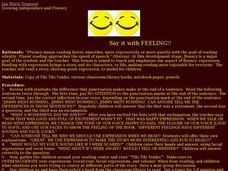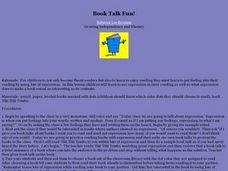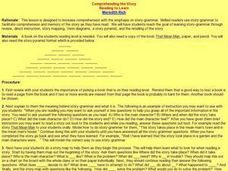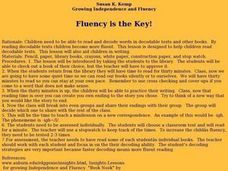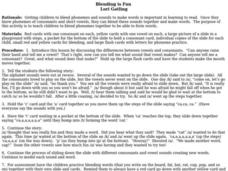Curated OER
Summarizing: James and the Giant Peach
Text marking and a T-chart format to distinguish important information from trivia help elementary readers summarize effectively. Encouraging readers to construct a chapter summary from paragraph-level topic sentences is another sound...
Curated OER
Bridge to Terabithia: Visualizing to Optimize Comprehension
Good readers visualize. And in our image-rich culture it is imperative that children are provided with opportunities to practice this important skill. A selection from Shel Silverstein’s Where the Sidewalk Ends and Bridge to Terabithia,...
Curated OER
Why?
Students discuss the concept of asking questions while reading. They discuss the types of questions to ask that will improve their comprehension. Students read from a textbook and practice creating questions to ask themselves while...
Curated OER
Question What You Read
Readers test their reading comprehension after reading a nonfiction text about Paleo Indians. (This text is in Alabama: It's History and Geography, but other texts can be used.) After reading the nonfiction article as a class, they...
Curated OER
Hop on the Express Train to Read Expressively
Encourage beginning readers to read expressively. After the teacher models what it's like to read with expression, pairs of learners work together to practice developing this ability. While one learner reads, the other marks a check-list...
Curated OER
Say it with FEELING!
Why should we read with expression when we read? Engage your learners in this discussion and teach them the easiest way to gauge expression: the end mark! Is it a question mark? An exclamation point? This helps you determine how to...
Curated OER
Expressive Eloquent Experts
What does it mean to read expressively? Beginning readers hear examples of expressive reading and partner up to practice. One partner reads The Littlest Pumpkin and the other partner reads Franklin and his Friend. While...
Curated OER
Read and Get Smart
Use the class textbook to read a full story about Martin Luther King, Jr. The class writes facts about him and outlines his life, then they read the author and illustrator summaries at the end of the story. They compare and contrast the...
Curated OER
Iggy the Penguin
Take your young word detectives on a hunt for the /i/ sound. Use the tongue twister about Iggy the penguin to help learners identify the target sound. Then learners are given several words, and they have to use their detective skills to...
Curated OER
OW! I stubbed by toe
Drill and practice the /ow/ sound! Kids practice recognizing pictures that begin with the ou=/ou/ correspondence. They experience a letterbox lesson to help implement this task before them as well as reading the story, The Napping House,...
Curated OER
Get the Chicks in the Coop
Readers work to increase the speed of their out-loud reading to improve overall fluency. They work with partners to time and record how far they read in one minute using the book Click, Clack, Moo Cows That Type. The procedures...
Curated OER
Be Expressive!
First through third graders explore reading with fluency and expression. They examine how to read with expression, changing the speed, volume, and pitch of their voices while reading. Students listen to a story that is read with...
Curated OER
Beginning to Read
Students explore various books read by their classmates outside of school. After reading books of their choice, the class creates a bulletin board summarizing their main ideas of the book and their opinion of the book using Flat Stanley.
Curated OER
Teaching Summarization
Examine the process of summarizing a piece of text using the book So You Want to Be a President? Kids review the definitions for main idea, topic sentences, superordinate terms, and supporting details. Next, they work in small...
Curated OER
Slim Pig
Beginning readers study the short /i/ sound. First they determine how the mouth moves when they say the target words in a tongue twister. They complete letterbox activities by making words with the short /i/ before reading What Is It and...
Curated OER
Book Talk Fun!: Growing Independence and Fluency
Master reading fluently and with emotion and expression! Young learners read and reread the book Tiki Tiki Tembo by Arlene Mosel to practice this strategy. The remark on the end punctuation to help them decide how to read the...
Curated OER
Comprehending the Story
Learners explore story-grammar. They discuss story-grammar and read That Mean Man. A story map is created and a Venn Diagram is used to compare and contrast concepts within the story. They retell the story and use a story pyramid to...
Curated OER
The 5 W's of Reading
Primary students will use the five "W" questions for reading comprehension as they read silently to themselves so that they can understand and remember what they have read. They then read The Velveteen Rabbit aloud, discussing the five...
Curated OER
Writing Process
Young scholars read "The Great Kapok" and choose to agree or disagree with the main character's decision. They gather and organize details from multiple sources to defend their standpoints. They begin prewriting steps of process writing.
Curated OER
Blast-Off to Blending
Practice working with different phonemes in consonants and vowels. Sounds are written on squares that get put on a rocket to "blast off" and meet other sounds. The teacher first models blending, then reads the new words. Young readers...
Curated OER
Fluency is the Key!
A field trip to the library begins this instructional activity where children select their own books to practice fluent silent reading. They then practice their writing by creating a new ending to the story they chose before receiving a...
Curated OER
Encore! Reading with Expression
When you read aloud from Roald Dahl's James and the Giant Peach, class members respond with "Encore!" or "No!" depending on your use, or misuse, of volume and speed as you demonstrate reading with expression. Readers then practice in...
Curated OER
Blending is Fun
Use a poster picture of a slide to illustrate the blending of phonemes in words. First show your youngsters basic examples like cat and cap. Then have learners work in pairs to create some blends of their own! Provide words for them to...
Curated OER
How Many Feet Will We Meet?
Emerging speakers distinguish between the sounds for short vowel /e/ and long vowel /e/. They are introduced to the vowel patterns that comprise the long vowel sounds, with emphasis on /ee/. They practice reading and spelling a variety...







